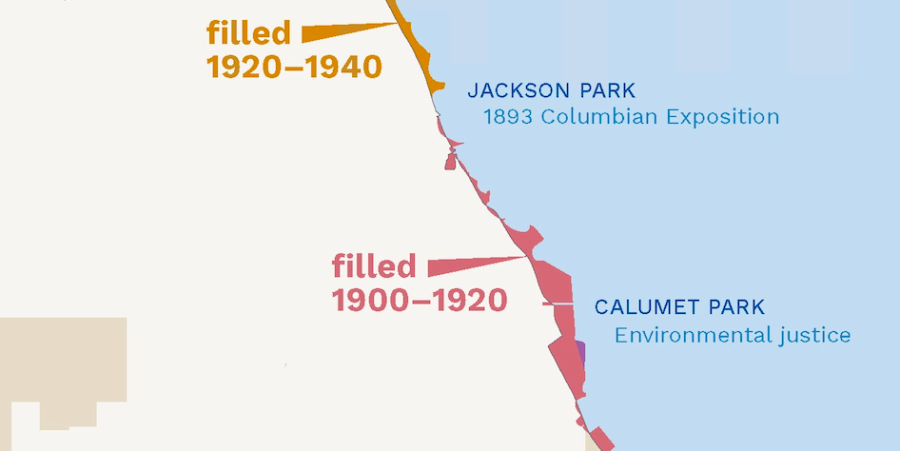JeeYeun Lee: Shore Land – Jackson Park to Steelworkers Park
@ Jackson Park to Steelworkers Park
6300 S Lake Shore Dr, Chicago, IL 60649
Opening Sunday, August 27th, at 11AM
Join us for a group outing, traveling from Jackson Park to Steelworkers Park. We will meet at 63rd Street Beach building. Please bring a smartphone, headphones, and be sure to wear comfortable shoes. Drinking water and sunscreen also recommended.
Shore Land is an audio piece contemplating the liminal space between land and water as simultaneously a public good, treaty violation, and strategy to suppress insurgence. Audio tracks are mapped onto six locations along the Chicago lakefront, meant to be listened to while walking, moving or simply being on this made land. Looking at how language creates place, even as place exceeds human language, Shore Land incorporates interviews, laws, treaties, stories, and songs in English, Potawatomi, and Korean.
We will begin with the track for Jackson Park, move as a group along the lakefront, and conclude with the track for Calumet Park. Anticipated walking time is 3 hours, traveling 6 miles. Feel free to join us for any duration!
ROMANSUSAN.ORG/SHORE-LAND
*****
From the first years of white settlement in Chicago, the Lake Michigan shore has been intensely engineered. Over the years, land has been constructed along the lake from trash, rubble of the Chicago Fire, dirt dug up from highway construction elsewhere in the city, and sand from the Indiana Dunes and the bottom of Lake Michigan. Now, more than 5.5 square miles of lakefill stretch across 30 miles of shore from Evanston to Indiana.
Most of this land is park space, hard won over decades by advocates inspired by Daniel Burnham’s 1909 Plan of Chicago. Often described as visionary and enlightened, the plan was also meant to facilitate business tycoons’ goals of creating wealth and reducing labor conflict. Parks were meant as recreational opportunities to divert working class laborers’ anger and resentment. Today’s concerns mostly center on extending public access along the privately owned sections north and south of the current lakefront trail, as well as addressing erosion and the increasing effects of climate change on lake levels.
Yet this land technically does not belong to the City, or to the public. As the Pokagon Band of Potawatomi insisted in a 1914 lawsuit against Chicago, the lakefill extends beyond treaty boundaries and thus was never ceded by Native people. What does it mean that this much-vaunted public lakefront was born from an elitist vision of urban control and breaks treaty law by its existence?
*****
JeeYeun Lee is an interdisciplinary artist, writer, and activist based in occupied Potawatomi territory now known as Chicago. Through performance, objects, and socially engaged art, her work explores dynamics of connection, power, violence and resistance. Her work has been shown in Chicago, Detroit, Santa Fe, Ohio, Missouri, and France. She has worked with social justice and community-based organizations for over thirty years in immigrant rights, economic justice, LGBTQ issues, and domestic violence. She holds an M.F.A. in Fiber from Cranbrook Academy of Art, M.A. in Ethnic Studies from the University of California at Berkeley, and B.A. in Linguistics from Stanford University. For additional information, please visit jeeyeunlee.com.
This work is a part of ROMANSUSAN.ORG/Navigations – a series of artist projects shared and realized in public/common space. This work has been supported by the Awesome Foundation (Chicago Chapter), the Puffin Foundation, and the Individual Artist Program of the Chicago Department of Cultural Affairs and Special Events.
The cover image here is adapted from materials by Dennis McClendon
Official Website
More events on this date
Tags: Chicago, JeeYeun Lee, Roman Susan, Shore Land – Jackson Park to Steelworkers Park, Woodlawn

« previous event
next event »